International Marketing Report: Tesco's Global Expansion Strategies
VerifiedAdded on 2023/01/11
|11
|3015
|23
Report
AI Summary
This report provides a detailed analysis of international marketing, using Tesco as a primary example. It covers key concepts, including the scope of international marketing, routes for market entry (such as licensing, direct exporting, and piggybacking), and selection criteria for entering international markets, with a focus on GDP growth and competition analysis. The report also explores various market entry strategies like joint ventures, franchising, and mergers. Furthermore, it delves into the global versus local debate, examining how product, pricing, promotion, and distribution strategies differ in international markets. Finally, the report analyzes different approaches to international marketing, emphasizing the importance of understanding cultural differences and currency fluctuations. The report provides insights into how Tesco can effectively navigate the complexities of the global marketplace to achieve its expansion goals.

INTERNATIONAL
MARKETING
MARKETING
Paraphrase This Document
Need a fresh take? Get an instant paraphrase of this document with our AI Paraphraser
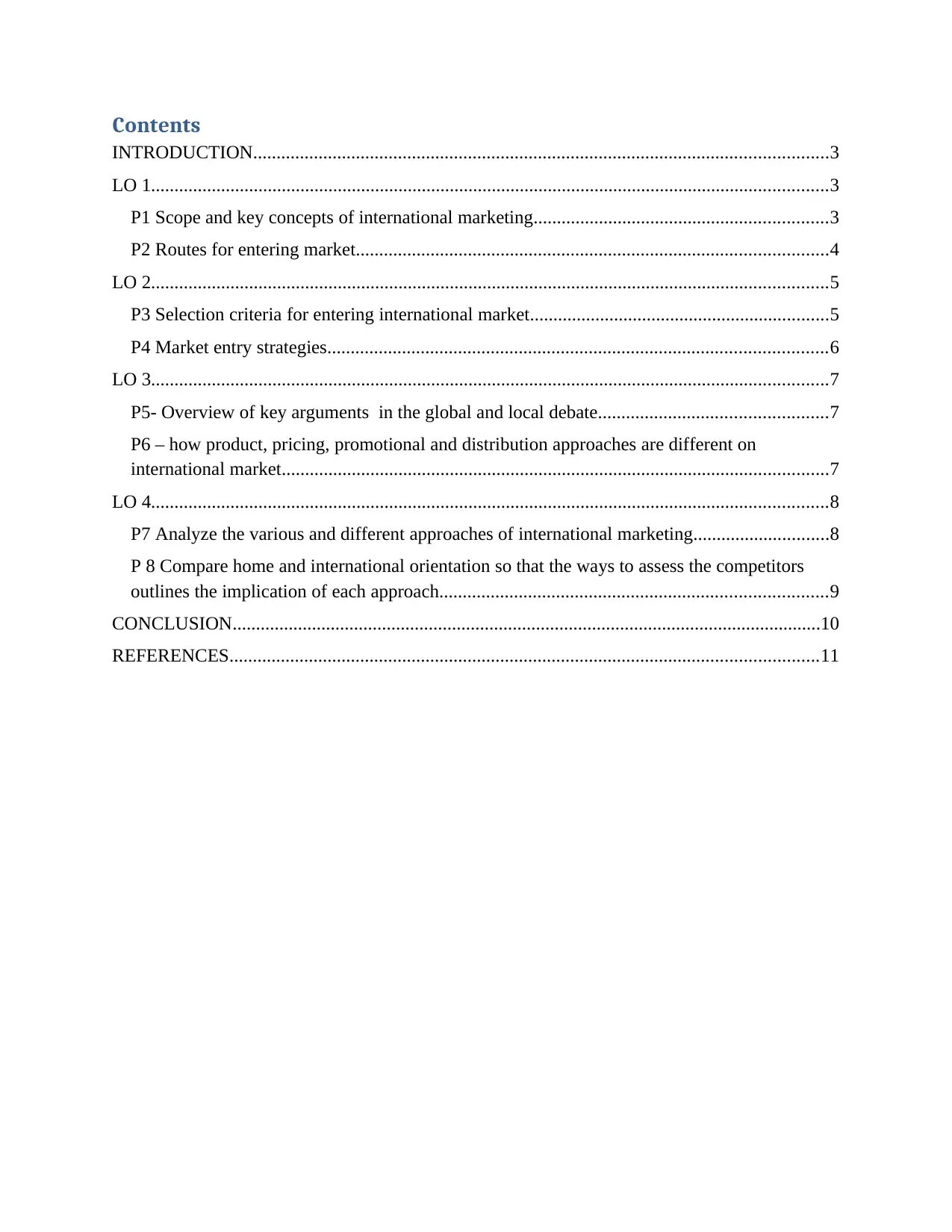
Contents
INTRODUCTION...........................................................................................................................3
LO 1.................................................................................................................................................3
P1 Scope and key concepts of international marketing...............................................................3
P2 Routes for entering market.....................................................................................................4
LO 2.................................................................................................................................................5
P3 Selection criteria for entering international market................................................................5
P4 Market entry strategies...........................................................................................................6
LO 3.................................................................................................................................................7
P5- Overview of key arguments in the global and local debate.................................................7
P6 – how product, pricing, promotional and distribution approaches are different on
international market.....................................................................................................................7
LO 4.................................................................................................................................................8
P7 Analyze the various and different approaches of international marketing.............................8
P 8 Compare home and international orientation so that the ways to assess the competitors
outlines the implication of each approach...................................................................................9
CONCLUSION..............................................................................................................................10
REFERENCES..............................................................................................................................11
INTRODUCTION...........................................................................................................................3
LO 1.................................................................................................................................................3
P1 Scope and key concepts of international marketing...............................................................3
P2 Routes for entering market.....................................................................................................4
LO 2.................................................................................................................................................5
P3 Selection criteria for entering international market................................................................5
P4 Market entry strategies...........................................................................................................6
LO 3.................................................................................................................................................7
P5- Overview of key arguments in the global and local debate.................................................7
P6 – how product, pricing, promotional and distribution approaches are different on
international market.....................................................................................................................7
LO 4.................................................................................................................................................8
P7 Analyze the various and different approaches of international marketing.............................8
P 8 Compare home and international orientation so that the ways to assess the competitors
outlines the implication of each approach...................................................................................9
CONCLUSION..............................................................................................................................10
REFERENCES..............................................................................................................................11
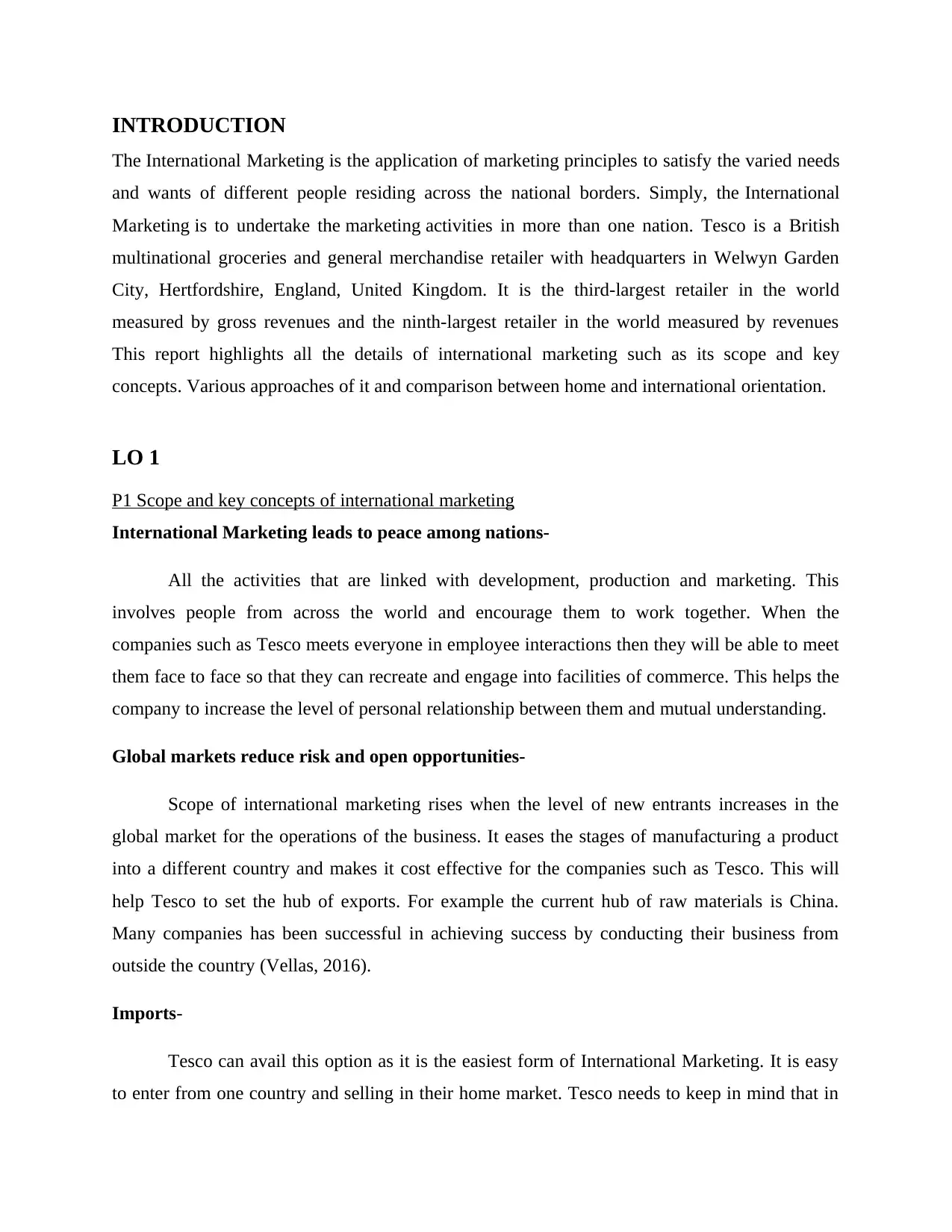
INTRODUCTION
The International Marketing is the application of marketing principles to satisfy the varied needs
and wants of different people residing across the national borders. Simply, the International
Marketing is to undertake the marketing activities in more than one nation. Tesco is a British
multinational groceries and general merchandise retailer with headquarters in Welwyn Garden
City, Hertfordshire, England, United Kingdom. It is the third-largest retailer in the world
measured by gross revenues and the ninth-largest retailer in the world measured by revenues
This report highlights all the details of international marketing such as its scope and key
concepts. Various approaches of it and comparison between home and international orientation.
LO 1
P1 Scope and key concepts of international marketing
International Marketing leads to peace among nations-
All the activities that are linked with development, production and marketing. This
involves people from across the world and encourage them to work together. When the
companies such as Tesco meets everyone in employee interactions then they will be able to meet
them face to face so that they can recreate and engage into facilities of commerce. This helps the
company to increase the level of personal relationship between them and mutual understanding.
Global markets reduce risk and open opportunities-
Scope of international marketing rises when the level of new entrants increases in the
global market for the operations of the business. It eases the stages of manufacturing a product
into a different country and makes it cost effective for the companies such as Tesco. This will
help Tesco to set the hub of exports. For example the current hub of raw materials is China.
Many companies has been successful in achieving success by conducting their business from
outside the country (Vellas, 2016).
Imports-
Tesco can avail this option as it is the easiest form of International Marketing. It is easy
to enter from one country and selling in their home market. Tesco needs to keep in mind that in
The International Marketing is the application of marketing principles to satisfy the varied needs
and wants of different people residing across the national borders. Simply, the International
Marketing is to undertake the marketing activities in more than one nation. Tesco is a British
multinational groceries and general merchandise retailer with headquarters in Welwyn Garden
City, Hertfordshire, England, United Kingdom. It is the third-largest retailer in the world
measured by gross revenues and the ninth-largest retailer in the world measured by revenues
This report highlights all the details of international marketing such as its scope and key
concepts. Various approaches of it and comparison between home and international orientation.
LO 1
P1 Scope and key concepts of international marketing
International Marketing leads to peace among nations-
All the activities that are linked with development, production and marketing. This
involves people from across the world and encourage them to work together. When the
companies such as Tesco meets everyone in employee interactions then they will be able to meet
them face to face so that they can recreate and engage into facilities of commerce. This helps the
company to increase the level of personal relationship between them and mutual understanding.
Global markets reduce risk and open opportunities-
Scope of international marketing rises when the level of new entrants increases in the
global market for the operations of the business. It eases the stages of manufacturing a product
into a different country and makes it cost effective for the companies such as Tesco. This will
help Tesco to set the hub of exports. For example the current hub of raw materials is China.
Many companies has been successful in achieving success by conducting their business from
outside the country (Vellas, 2016).
Imports-
Tesco can avail this option as it is the easiest form of International Marketing. It is easy
to enter from one country and selling in their home market. Tesco needs to keep in mind that in
⊘ This is a preview!⊘
Do you want full access?
Subscribe today to unlock all pages.

Trusted by 1+ million students worldwide
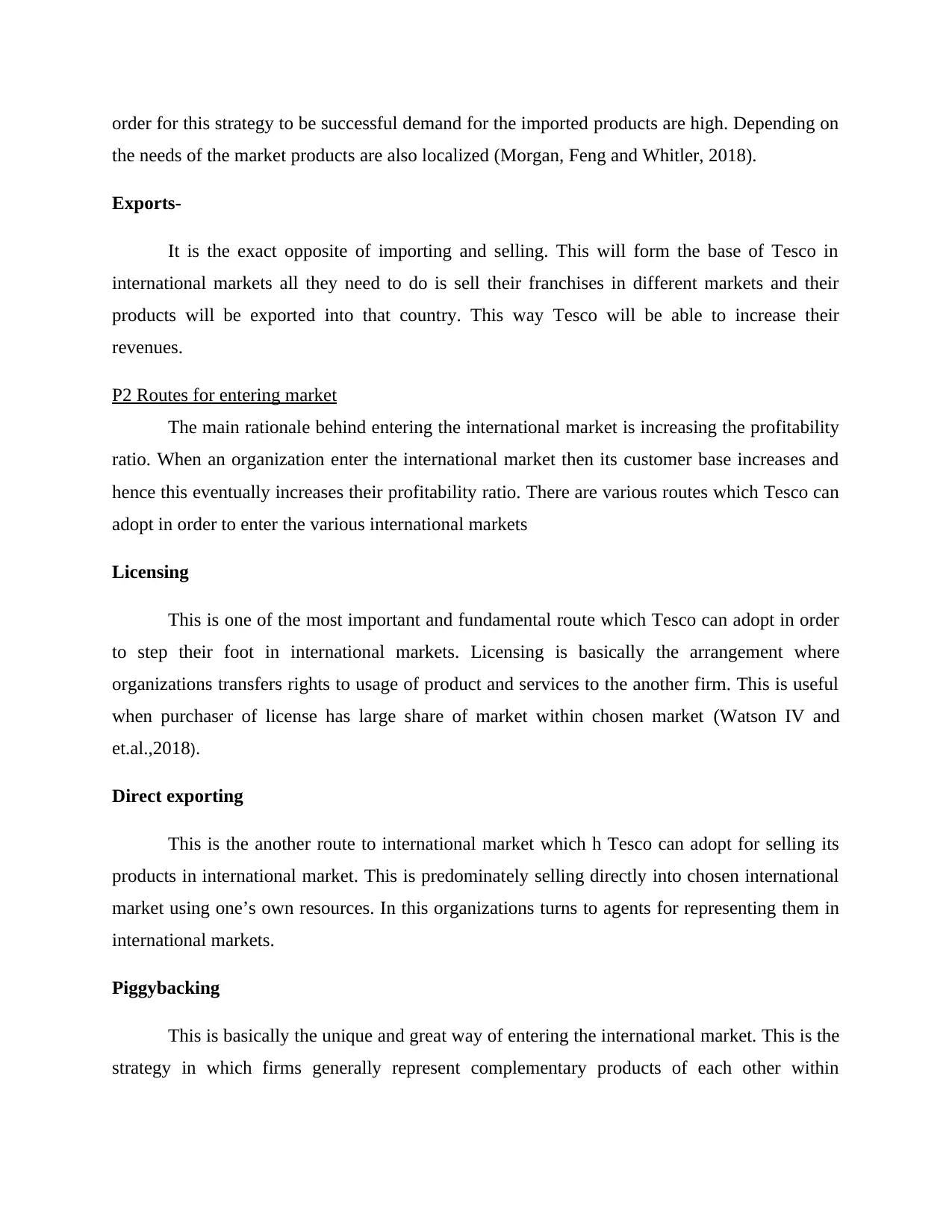
order for this strategy to be successful demand for the imported products are high. Depending on
the needs of the market products are also localized (Morgan, Feng and Whitler, 2018).
Exports-
It is the exact opposite of importing and selling. This will form the base of Tesco in
international markets all they need to do is sell their franchises in different markets and their
products will be exported into that country. This way Tesco will be able to increase their
revenues.
P2 Routes for entering market
The main rationale behind entering the international market is increasing the profitability
ratio. When an organization enter the international market then its customer base increases and
hence this eventually increases their profitability ratio. There are various routes which Tesco can
adopt in order to enter the various international markets
Licensing
This is one of the most important and fundamental route which Tesco can adopt in order
to step their foot in international markets. Licensing is basically the arrangement where
organizations transfers rights to usage of product and services to the another firm. This is useful
when purchaser of license has large share of market within chosen market (Watson IV and
et.al.,2018).
Direct exporting
This is the another route to international market which h Tesco can adopt for selling its
products in international market. This is predominately selling directly into chosen international
market using one’s own resources. In this organizations turns to agents for representing them in
international markets.
Piggybacking
This is basically the unique and great way of entering the international market. This is the
strategy in which firms generally represent complementary products of each other within
the needs of the market products are also localized (Morgan, Feng and Whitler, 2018).
Exports-
It is the exact opposite of importing and selling. This will form the base of Tesco in
international markets all they need to do is sell their franchises in different markets and their
products will be exported into that country. This way Tesco will be able to increase their
revenues.
P2 Routes for entering market
The main rationale behind entering the international market is increasing the profitability
ratio. When an organization enter the international market then its customer base increases and
hence this eventually increases their profitability ratio. There are various routes which Tesco can
adopt in order to enter the various international markets
Licensing
This is one of the most important and fundamental route which Tesco can adopt in order
to step their foot in international markets. Licensing is basically the arrangement where
organizations transfers rights to usage of product and services to the another firm. This is useful
when purchaser of license has large share of market within chosen market (Watson IV and
et.al.,2018).
Direct exporting
This is the another route to international market which h Tesco can adopt for selling its
products in international market. This is predominately selling directly into chosen international
market using one’s own resources. In this organizations turns to agents for representing them in
international markets.
Piggybacking
This is basically the unique and great way of entering the international market. This is the
strategy in which firms generally represent complementary products of each other within
Paraphrase This Document
Need a fresh take? Get an instant paraphrase of this document with our AI Paraphraser
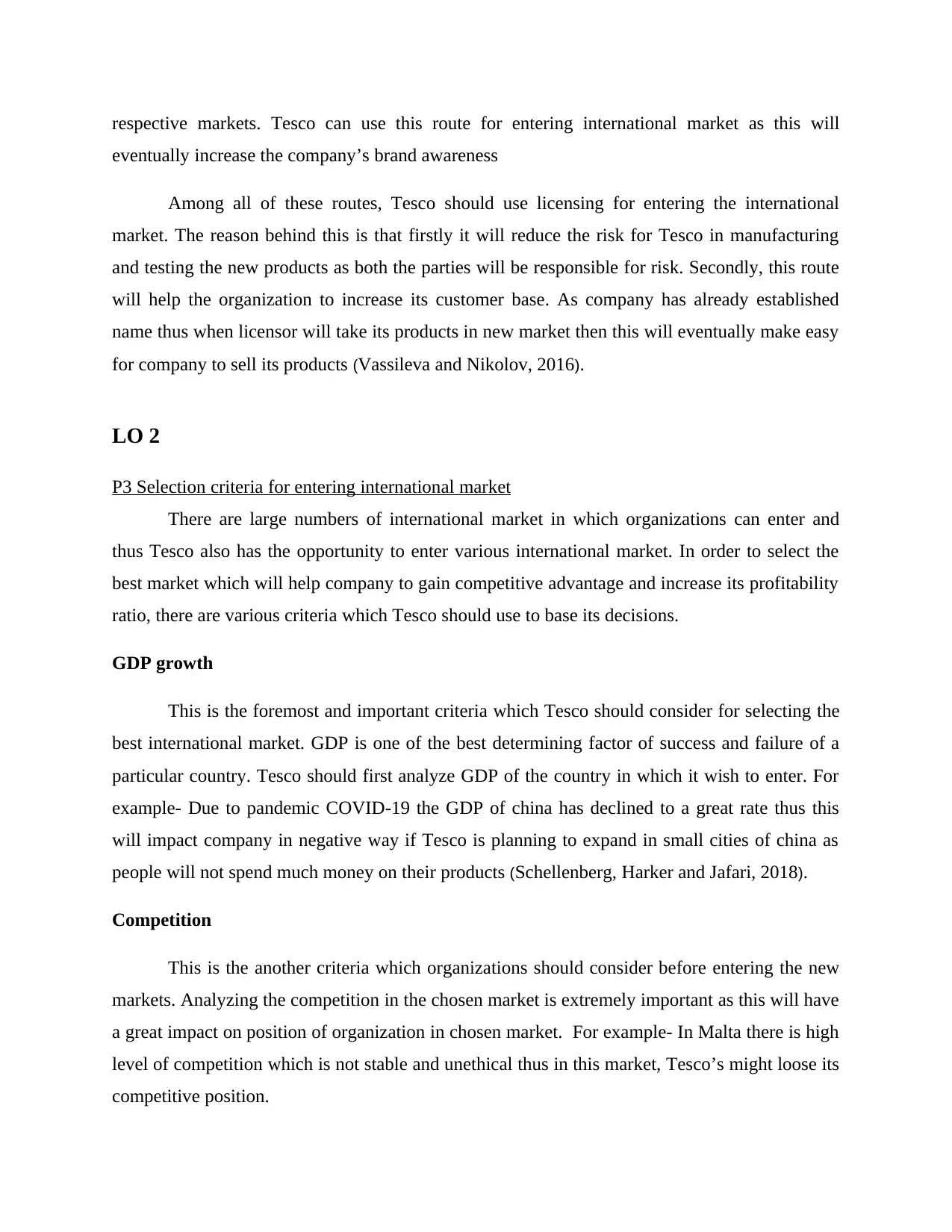
respective markets. Tesco can use this route for entering international market as this will
eventually increase the company’s brand awareness
Among all of these routes, Tesco should use licensing for entering the international
market. The reason behind this is that firstly it will reduce the risk for Tesco in manufacturing
and testing the new products as both the parties will be responsible for risk. Secondly, this route
will help the organization to increase its customer base. As company has already established
name thus when licensor will take its products in new market then this will eventually make easy
for company to sell its products (Vassileva and Nikolov, 2016).
LO 2
P3 Selection criteria for entering international market
There are large numbers of international market in which organizations can enter and
thus Tesco also has the opportunity to enter various international market. In order to select the
best market which will help company to gain competitive advantage and increase its profitability
ratio, there are various criteria which Tesco should use to base its decisions.
GDP growth
This is the foremost and important criteria which Tesco should consider for selecting the
best international market. GDP is one of the best determining factor of success and failure of a
particular country. Tesco should first analyze GDP of the country in which it wish to enter. For
example- Due to pandemic COVID-19 the GDP of china has declined to a great rate thus this
will impact company in negative way if Tesco is planning to expand in small cities of china as
people will not spend much money on their products (Schellenberg, Harker and Jafari, 2018).
Competition
This is the another criteria which organizations should consider before entering the new
markets. Analyzing the competition in the chosen market is extremely important as this will have
a great impact on position of organization in chosen market. For example- In Malta there is high
level of competition which is not stable and unethical thus in this market, Tesco’s might loose its
competitive position.
eventually increase the company’s brand awareness
Among all of these routes, Tesco should use licensing for entering the international
market. The reason behind this is that firstly it will reduce the risk for Tesco in manufacturing
and testing the new products as both the parties will be responsible for risk. Secondly, this route
will help the organization to increase its customer base. As company has already established
name thus when licensor will take its products in new market then this will eventually make easy
for company to sell its products (Vassileva and Nikolov, 2016).
LO 2
P3 Selection criteria for entering international market
There are large numbers of international market in which organizations can enter and
thus Tesco also has the opportunity to enter various international market. In order to select the
best market which will help company to gain competitive advantage and increase its profitability
ratio, there are various criteria which Tesco should use to base its decisions.
GDP growth
This is the foremost and important criteria which Tesco should consider for selecting the
best international market. GDP is one of the best determining factor of success and failure of a
particular country. Tesco should first analyze GDP of the country in which it wish to enter. For
example- Due to pandemic COVID-19 the GDP of china has declined to a great rate thus this
will impact company in negative way if Tesco is planning to expand in small cities of china as
people will not spend much money on their products (Schellenberg, Harker and Jafari, 2018).
Competition
This is the another criteria which organizations should consider before entering the new
markets. Analyzing the competition in the chosen market is extremely important as this will have
a great impact on position of organization in chosen market. For example- In Malta there is high
level of competition which is not stable and unethical thus in this market, Tesco’s might loose its
competitive position.
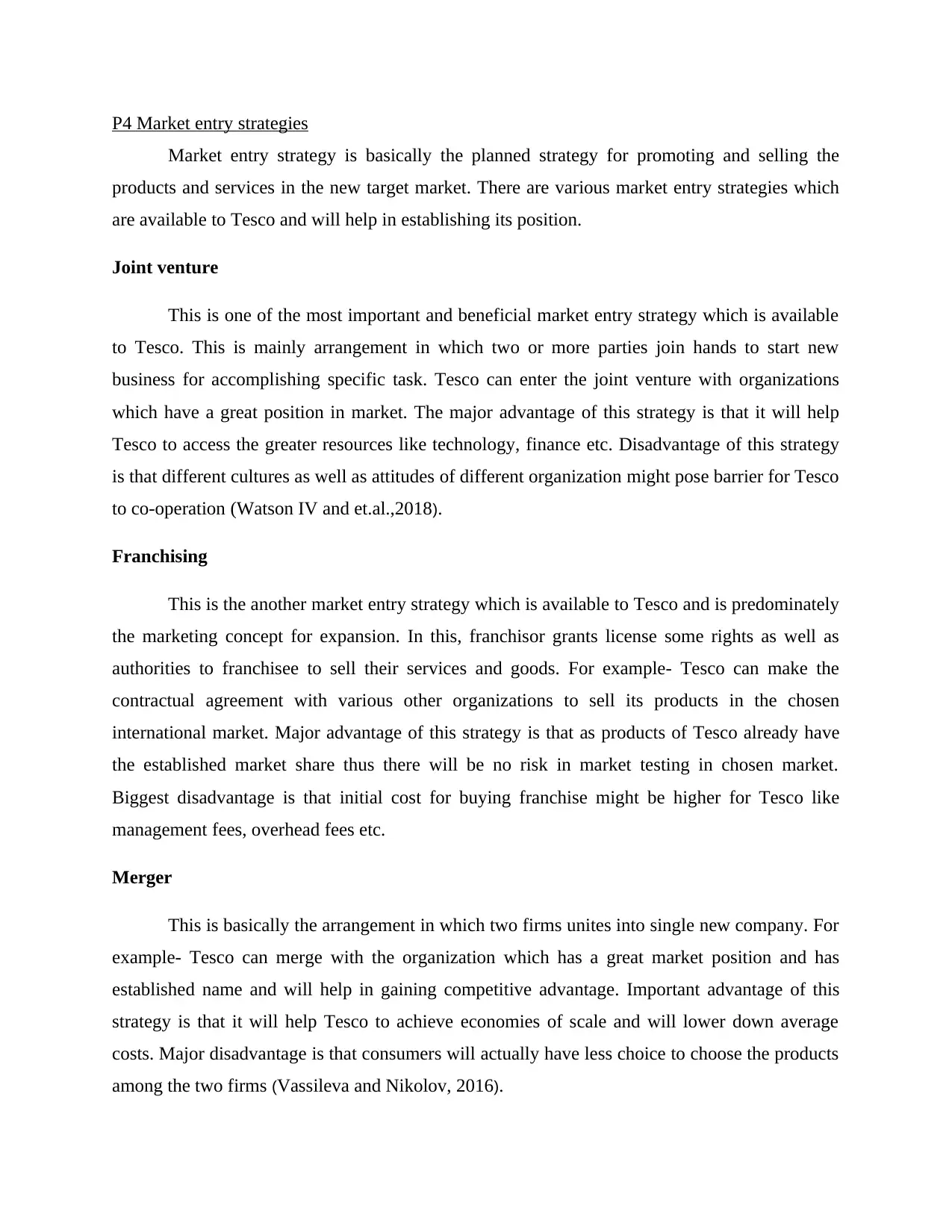
P4 Market entry strategies
Market entry strategy is basically the planned strategy for promoting and selling the
products and services in the new target market. There are various market entry strategies which
are available to Tesco and will help in establishing its position.
Joint venture
This is one of the most important and beneficial market entry strategy which is available
to Tesco. This is mainly arrangement in which two or more parties join hands to start new
business for accomplishing specific task. Tesco can enter the joint venture with organizations
which have a great position in market. The major advantage of this strategy is that it will help
Tesco to access the greater resources like technology, finance etc. Disadvantage of this strategy
is that different cultures as well as attitudes of different organization might pose barrier for Tesco
to co-operation (Watson IV and et.al.,2018).
Franchising
This is the another market entry strategy which is available to Tesco and is predominately
the marketing concept for expansion. In this, franchisor grants license some rights as well as
authorities to franchisee to sell their services and goods. For example- Tesco can make the
contractual agreement with various other organizations to sell its products in the chosen
international market. Major advantage of this strategy is that as products of Tesco already have
the established market share thus there will be no risk in market testing in chosen market.
Biggest disadvantage is that initial cost for buying franchise might be higher for Tesco like
management fees, overhead fees etc.
Merger
This is basically the arrangement in which two firms unites into single new company. For
example- Tesco can merge with the organization which has a great market position and has
established name and will help in gaining competitive advantage. Important advantage of this
strategy is that it will help Tesco to achieve economies of scale and will lower down average
costs. Major disadvantage is that consumers will actually have less choice to choose the products
among the two firms (Vassileva and Nikolov, 2016).
Market entry strategy is basically the planned strategy for promoting and selling the
products and services in the new target market. There are various market entry strategies which
are available to Tesco and will help in establishing its position.
Joint venture
This is one of the most important and beneficial market entry strategy which is available
to Tesco. This is mainly arrangement in which two or more parties join hands to start new
business for accomplishing specific task. Tesco can enter the joint venture with organizations
which have a great position in market. The major advantage of this strategy is that it will help
Tesco to access the greater resources like technology, finance etc. Disadvantage of this strategy
is that different cultures as well as attitudes of different organization might pose barrier for Tesco
to co-operation (Watson IV and et.al.,2018).
Franchising
This is the another market entry strategy which is available to Tesco and is predominately
the marketing concept for expansion. In this, franchisor grants license some rights as well as
authorities to franchisee to sell their services and goods. For example- Tesco can make the
contractual agreement with various other organizations to sell its products in the chosen
international market. Major advantage of this strategy is that as products of Tesco already have
the established market share thus there will be no risk in market testing in chosen market.
Biggest disadvantage is that initial cost for buying franchise might be higher for Tesco like
management fees, overhead fees etc.
Merger
This is basically the arrangement in which two firms unites into single new company. For
example- Tesco can merge with the organization which has a great market position and has
established name and will help in gaining competitive advantage. Important advantage of this
strategy is that it will help Tesco to achieve economies of scale and will lower down average
costs. Major disadvantage is that consumers will actually have less choice to choose the products
among the two firms (Vassileva and Nikolov, 2016).
⊘ This is a preview!⊘
Do you want full access?
Subscribe today to unlock all pages.

Trusted by 1+ million students worldwide
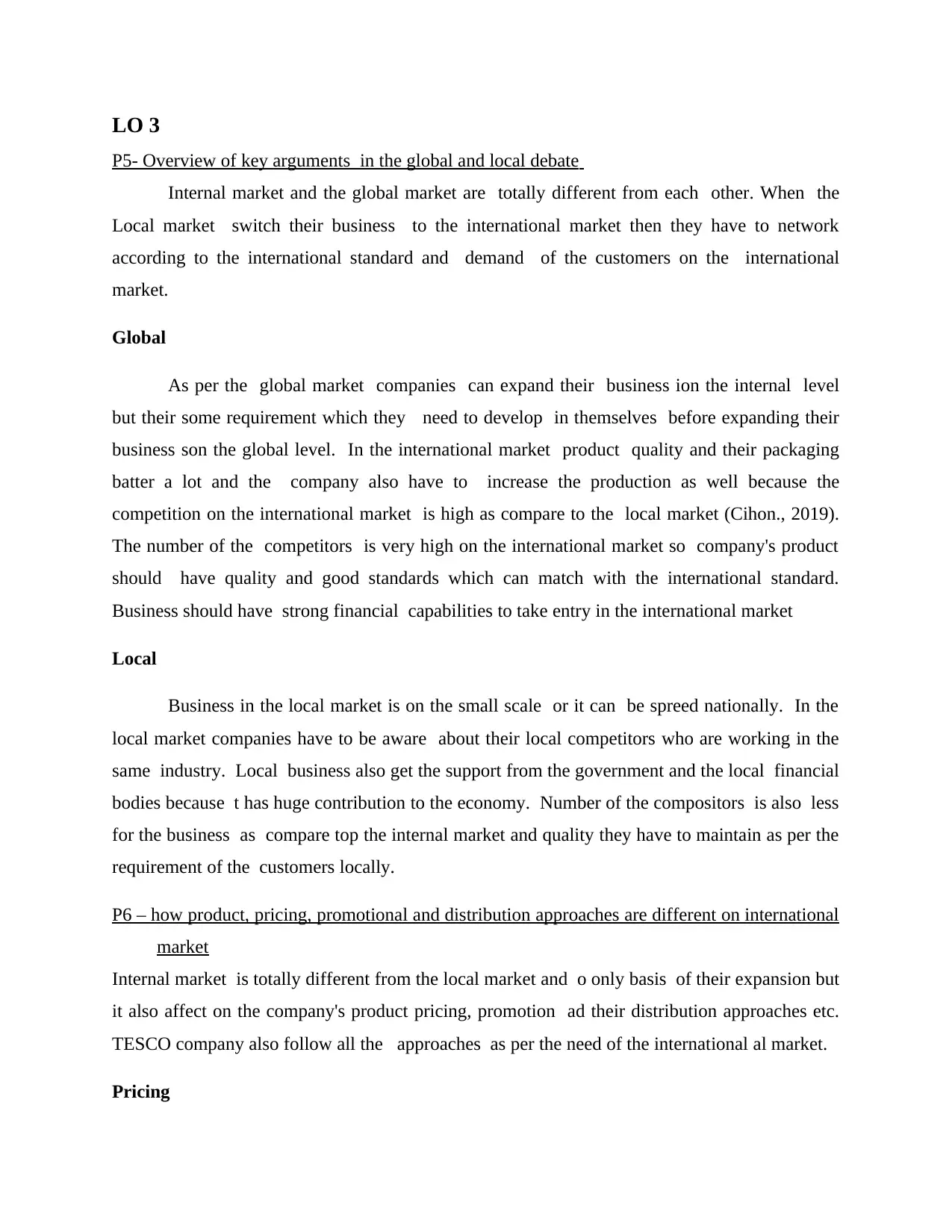
LO 3
P5- Overview of key arguments in the global and local debate
Internal market and the global market are totally different from each other. When the
Local market switch their business to the international market then they have to network
according to the international standard and demand of the customers on the international
market.
Global
As per the global market companies can expand their business ion the internal level
but their some requirement which they need to develop in themselves before expanding their
business son the global level. In the international market product quality and their packaging
batter a lot and the company also have to increase the production as well because the
competition on the international market is high as compare to the local market (Cihon., 2019).
The number of the competitors is very high on the international market so company's product
should have quality and good standards which can match with the international standard.
Business should have strong financial capabilities to take entry in the international market
Local
Business in the local market is on the small scale or it can be spreed nationally. In the
local market companies have to be aware about their local competitors who are working in the
same industry. Local business also get the support from the government and the local financial
bodies because t has huge contribution to the economy. Number of the compositors is also less
for the business as compare top the internal market and quality they have to maintain as per the
requirement of the customers locally.
P6 – how product, pricing, promotional and distribution approaches are different on international
market
Internal market is totally different from the local market and o only basis of their expansion but
it also affect on the company's product pricing, promotion ad their distribution approaches etc.
TESCO company also follow all the approaches as per the need of the international al market.
Pricing
P5- Overview of key arguments in the global and local debate
Internal market and the global market are totally different from each other. When the
Local market switch their business to the international market then they have to network
according to the international standard and demand of the customers on the international
market.
Global
As per the global market companies can expand their business ion the internal level
but their some requirement which they need to develop in themselves before expanding their
business son the global level. In the international market product quality and their packaging
batter a lot and the company also have to increase the production as well because the
competition on the international market is high as compare to the local market (Cihon., 2019).
The number of the competitors is very high on the international market so company's product
should have quality and good standards which can match with the international standard.
Business should have strong financial capabilities to take entry in the international market
Local
Business in the local market is on the small scale or it can be spreed nationally. In the
local market companies have to be aware about their local competitors who are working in the
same industry. Local business also get the support from the government and the local financial
bodies because t has huge contribution to the economy. Number of the compositors is also less
for the business as compare top the internal market and quality they have to maintain as per the
requirement of the customers locally.
P6 – how product, pricing, promotional and distribution approaches are different on international
market
Internal market is totally different from the local market and o only basis of their expansion but
it also affect on the company's product pricing, promotion ad their distribution approaches etc.
TESCO company also follow all the approaches as per the need of the international al market.
Pricing
Paraphrase This Document
Need a fresh take? Get an instant paraphrase of this document with our AI Paraphraser
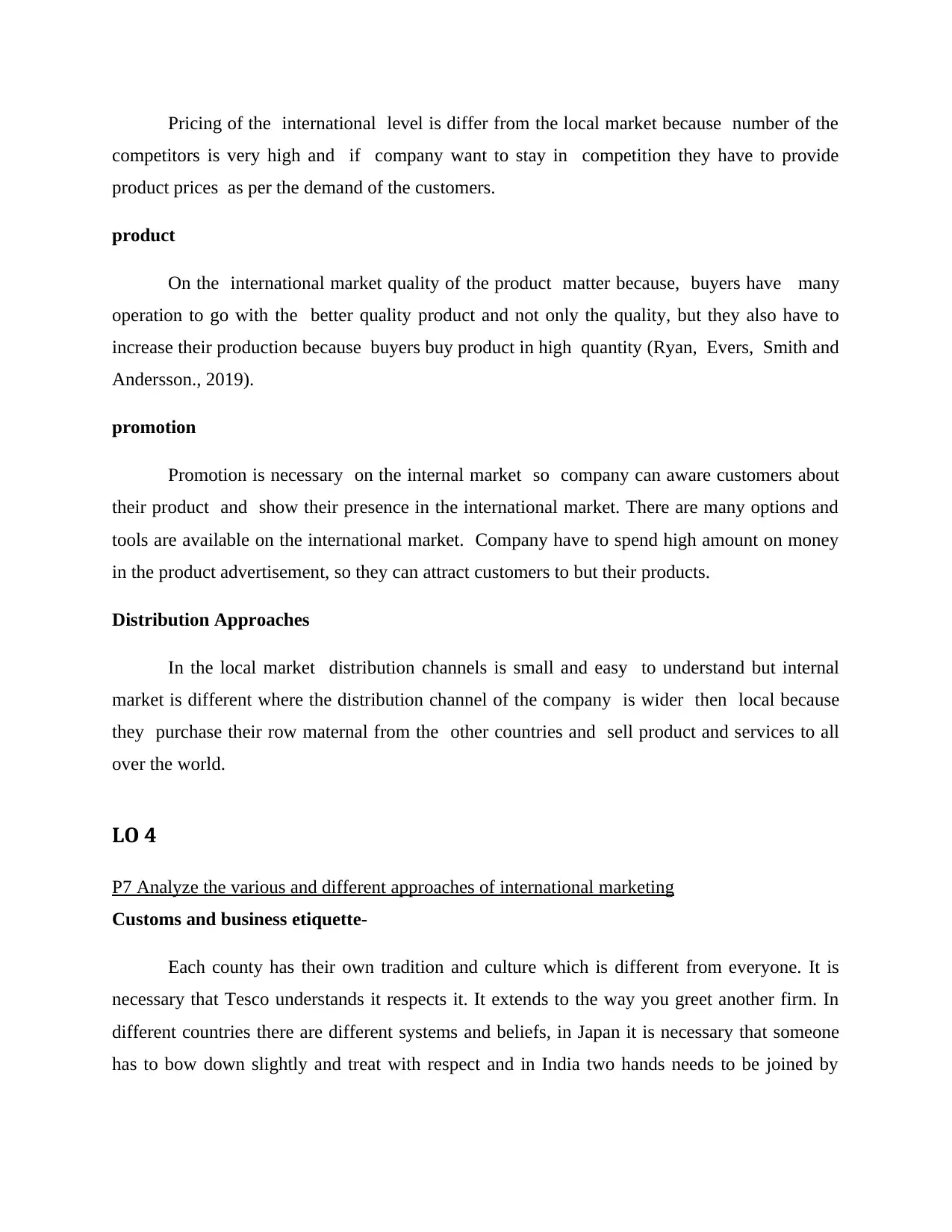
Pricing of the international level is differ from the local market because number of the
competitors is very high and if company want to stay in competition they have to provide
product prices as per the demand of the customers.
product
On the international market quality of the product matter because, buyers have many
operation to go with the better quality product and not only the quality, but they also have to
increase their production because buyers buy product in high quantity (Ryan, Evers, Smith and
Andersson., 2019).
promotion
Promotion is necessary on the internal market so company can aware customers about
their product and show their presence in the international market. There are many options and
tools are available on the international market. Company have to spend high amount on money
in the product advertisement, so they can attract customers to but their products.
Distribution Approaches
In the local market distribution channels is small and easy to understand but internal
market is different where the distribution channel of the company is wider then local because
they purchase their row maternal from the other countries and sell product and services to all
over the world.
LO 4
P7 Analyze the various and different approaches of international marketing
Customs and business etiquette-
Each county has their own tradition and culture which is different from everyone. It is
necessary that Tesco understands it respects it. It extends to the way you greet another firm. In
different countries there are different systems and beliefs, in Japan it is necessary that someone
has to bow down slightly and treat with respect and in India two hands needs to be joined by
competitors is very high and if company want to stay in competition they have to provide
product prices as per the demand of the customers.
product
On the international market quality of the product matter because, buyers have many
operation to go with the better quality product and not only the quality, but they also have to
increase their production because buyers buy product in high quantity (Ryan, Evers, Smith and
Andersson., 2019).
promotion
Promotion is necessary on the internal market so company can aware customers about
their product and show their presence in the international market. There are many options and
tools are available on the international market. Company have to spend high amount on money
in the product advertisement, so they can attract customers to but their products.
Distribution Approaches
In the local market distribution channels is small and easy to understand but internal
market is different where the distribution channel of the company is wider then local because
they purchase their row maternal from the other countries and sell product and services to all
over the world.
LO 4
P7 Analyze the various and different approaches of international marketing
Customs and business etiquette-
Each county has their own tradition and culture which is different from everyone. It is
necessary that Tesco understands it respects it. It extends to the way you greet another firm. In
different countries there are different systems and beliefs, in Japan it is necessary that someone
has to bow down slightly and treat with respect and in India two hands needs to be joined by
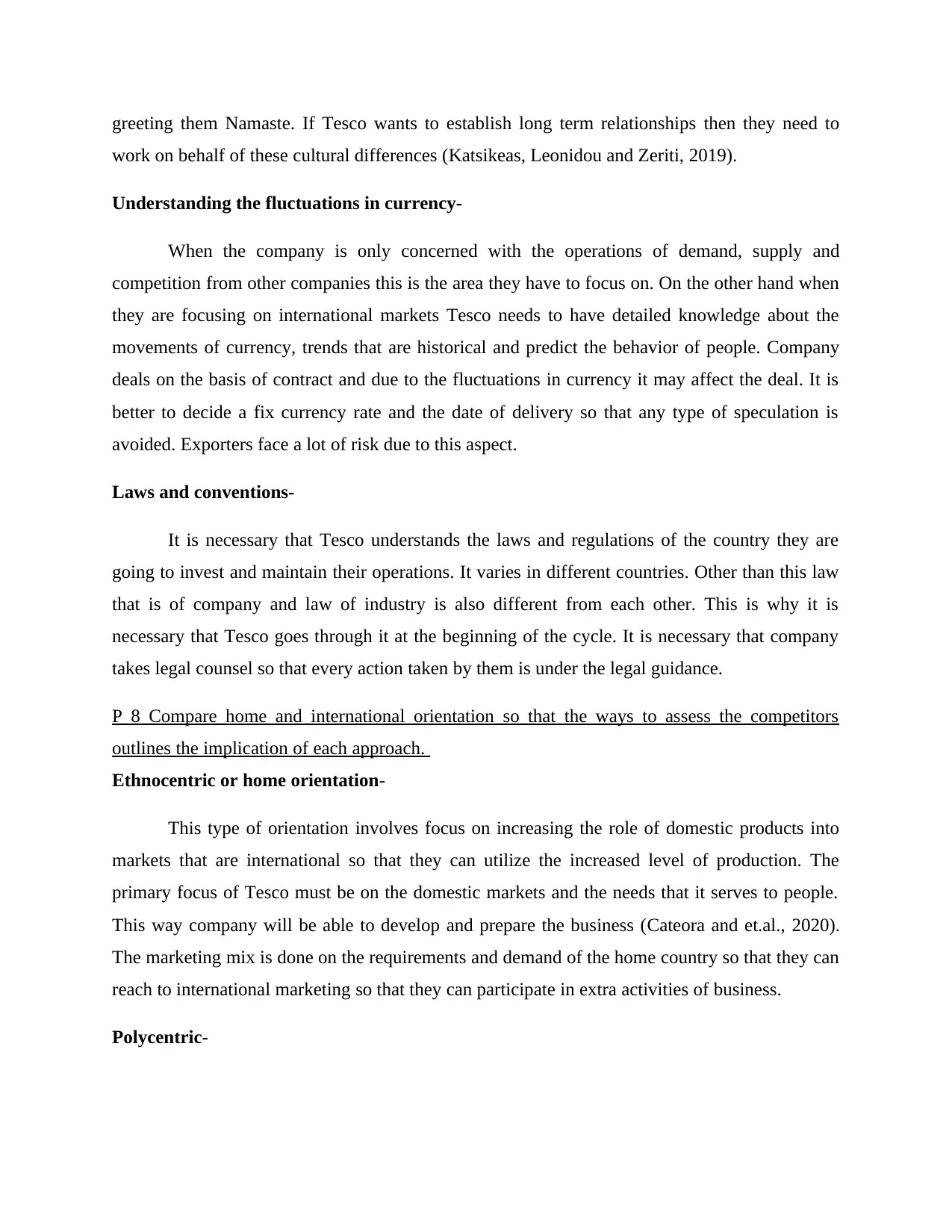
greeting them Namaste. If Tesco wants to establish long term relationships then they need to
work on behalf of these cultural differences (Katsikeas, Leonidou and Zeriti, 2019).
Understanding the fluctuations in currency-
When the company is only concerned with the operations of demand, supply and
competition from other companies this is the area they have to focus on. On the other hand when
they are focusing on international markets Tesco needs to have detailed knowledge about the
movements of currency, trends that are historical and predict the behavior of people. Company
deals on the basis of contract and due to the fluctuations in currency it may affect the deal. It is
better to decide a fix currency rate and the date of delivery so that any type of speculation is
avoided. Exporters face a lot of risk due to this aspect.
Laws and conventions-
It is necessary that Tesco understands the laws and regulations of the country they are
going to invest and maintain their operations. It varies in different countries. Other than this law
that is of company and law of industry is also different from each other. This is why it is
necessary that Tesco goes through it at the beginning of the cycle. It is necessary that company
takes legal counsel so that every action taken by them is under the legal guidance.
P 8 Compare home and international orientation so that the ways to assess the competitors
outlines the implication of each approach.
Ethnocentric or home orientation-
This type of orientation involves focus on increasing the role of domestic products into
markets that are international so that they can utilize the increased level of production. The
primary focus of Tesco must be on the domestic markets and the needs that it serves to people.
This way company will be able to develop and prepare the business (Cateora and et.al., 2020).
The marketing mix is done on the requirements and demand of the home country so that they can
reach to international marketing so that they can participate in extra activities of business.
Polycentric-
work on behalf of these cultural differences (Katsikeas, Leonidou and Zeriti, 2019).
Understanding the fluctuations in currency-
When the company is only concerned with the operations of demand, supply and
competition from other companies this is the area they have to focus on. On the other hand when
they are focusing on international markets Tesco needs to have detailed knowledge about the
movements of currency, trends that are historical and predict the behavior of people. Company
deals on the basis of contract and due to the fluctuations in currency it may affect the deal. It is
better to decide a fix currency rate and the date of delivery so that any type of speculation is
avoided. Exporters face a lot of risk due to this aspect.
Laws and conventions-
It is necessary that Tesco understands the laws and regulations of the country they are
going to invest and maintain their operations. It varies in different countries. Other than this law
that is of company and law of industry is also different from each other. This is why it is
necessary that Tesco goes through it at the beginning of the cycle. It is necessary that company
takes legal counsel so that every action taken by them is under the legal guidance.
P 8 Compare home and international orientation so that the ways to assess the competitors
outlines the implication of each approach.
Ethnocentric or home orientation-
This type of orientation involves focus on increasing the role of domestic products into
markets that are international so that they can utilize the increased level of production. The
primary focus of Tesco must be on the domestic markets and the needs that it serves to people.
This way company will be able to develop and prepare the business (Cateora and et.al., 2020).
The marketing mix is done on the requirements and demand of the home country so that they can
reach to international marketing so that they can participate in extra activities of business.
Polycentric-
⊘ This is a preview!⊘
Do you want full access?
Subscribe today to unlock all pages.

Trusted by 1+ million students worldwide
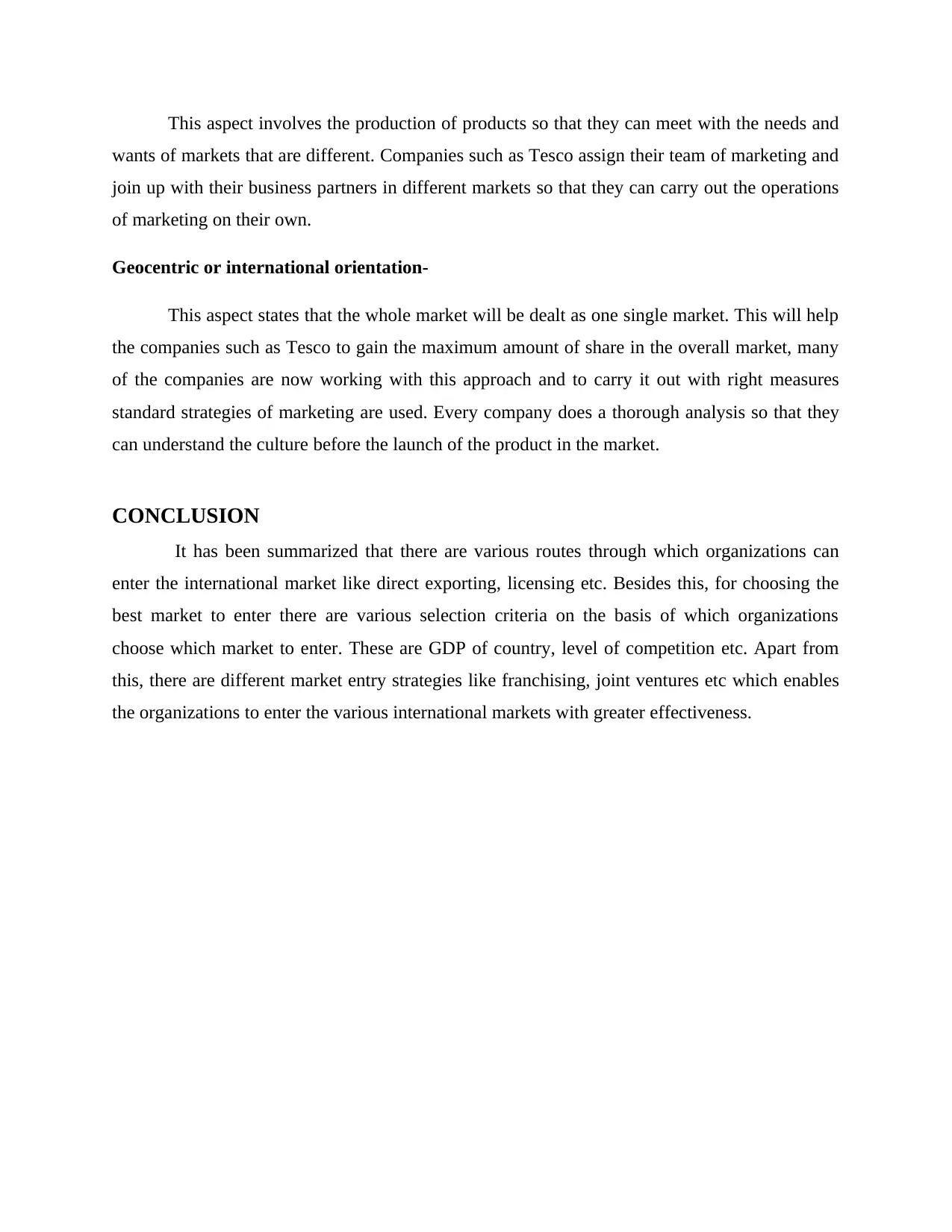
This aspect involves the production of products so that they can meet with the needs and
wants of markets that are different. Companies such as Tesco assign their team of marketing and
join up with their business partners in different markets so that they can carry out the operations
of marketing on their own.
Geocentric or international orientation-
This aspect states that the whole market will be dealt as one single market. This will help
the companies such as Tesco to gain the maximum amount of share in the overall market, many
of the companies are now working with this approach and to carry it out with right measures
standard strategies of marketing are used. Every company does a thorough analysis so that they
can understand the culture before the launch of the product in the market.
CONCLUSION
It has been summarized that there are various routes through which organizations can
enter the international market like direct exporting, licensing etc. Besides this, for choosing the
best market to enter there are various selection criteria on the basis of which organizations
choose which market to enter. These are GDP of country, level of competition etc. Apart from
this, there are different market entry strategies like franchising, joint ventures etc which enables
the organizations to enter the various international markets with greater effectiveness.
wants of markets that are different. Companies such as Tesco assign their team of marketing and
join up with their business partners in different markets so that they can carry out the operations
of marketing on their own.
Geocentric or international orientation-
This aspect states that the whole market will be dealt as one single market. This will help
the companies such as Tesco to gain the maximum amount of share in the overall market, many
of the companies are now working with this approach and to carry it out with right measures
standard strategies of marketing are used. Every company does a thorough analysis so that they
can understand the culture before the launch of the product in the market.
CONCLUSION
It has been summarized that there are various routes through which organizations can
enter the international market like direct exporting, licensing etc. Besides this, for choosing the
best market to enter there are various selection criteria on the basis of which organizations
choose which market to enter. These are GDP of country, level of competition etc. Apart from
this, there are different market entry strategies like franchising, joint ventures etc which enables
the organizations to enter the various international markets with greater effectiveness.
Paraphrase This Document
Need a fresh take? Get an instant paraphrase of this document with our AI Paraphraser
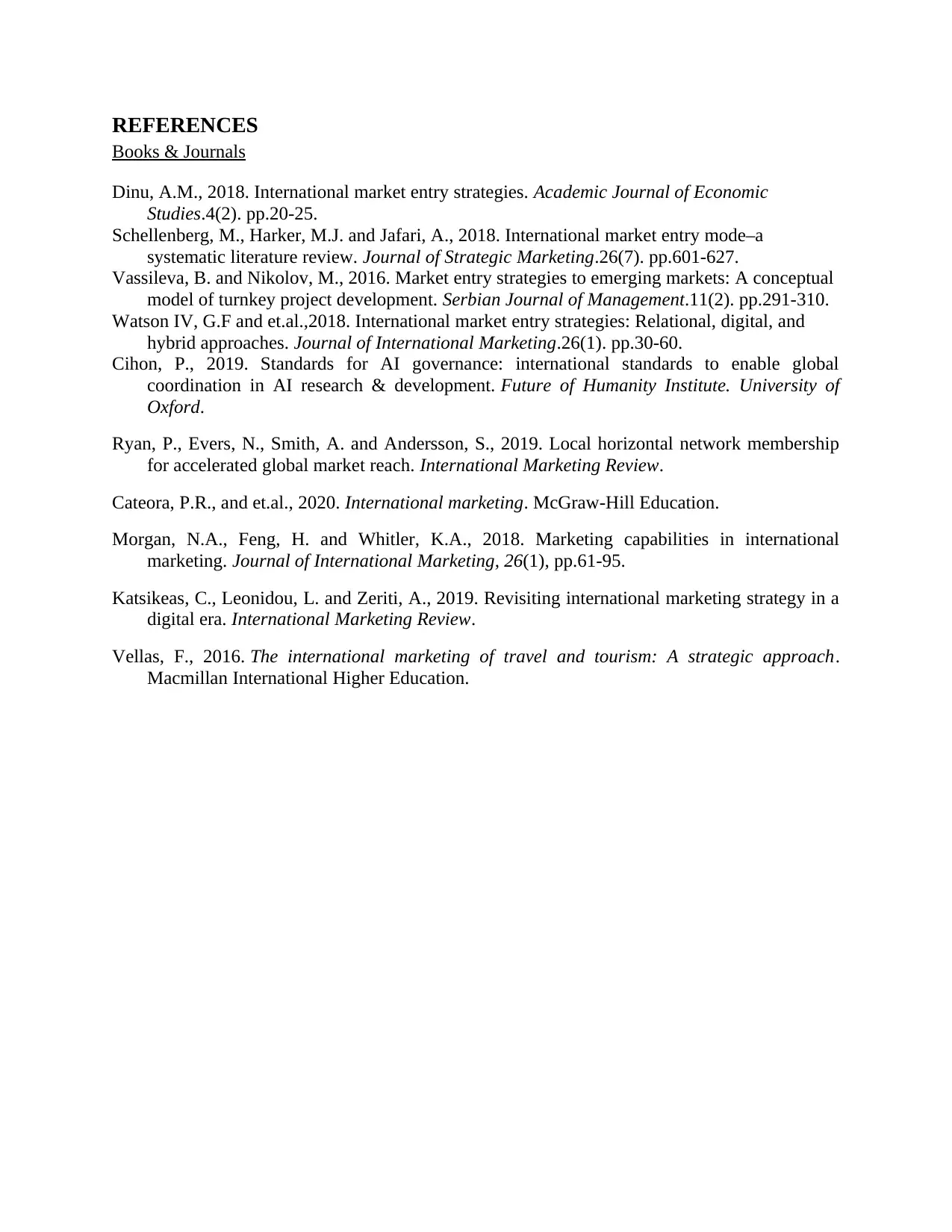
REFERENCES
Books & Journals
Dinu, A.M., 2018. International market entry strategies. Academic Journal of Economic
Studies.4(2). pp.20-25.
Schellenberg, M., Harker, M.J. and Jafari, A., 2018. International market entry mode–a
systematic literature review. Journal of Strategic Marketing.26(7). pp.601-627.
Vassileva, B. and Nikolov, M., 2016. Market entry strategies to emerging markets: A conceptual
model of turnkey project development. Serbian Journal of Management.11(2). pp.291-310.
Watson IV, G.F and et.al.,2018. International market entry strategies: Relational, digital, and
hybrid approaches. Journal of International Marketing.26(1). pp.30-60.
Cihon, P., 2019. Standards for AI governance: international standards to enable global
coordination in AI research & development. Future of Humanity Institute. University of
Oxford.
Ryan, P., Evers, N., Smith, A. and Andersson, S., 2019. Local horizontal network membership
for accelerated global market reach. International Marketing Review.
Cateora, P.R., and et.al., 2020. International marketing. McGraw-Hill Education.
Morgan, N.A., Feng, H. and Whitler, K.A., 2018. Marketing capabilities in international
marketing. Journal of International Marketing, 26(1), pp.61-95.
Katsikeas, C., Leonidou, L. and Zeriti, A., 2019. Revisiting international marketing strategy in a
digital era. International Marketing Review.
Vellas, F., 2016. The international marketing of travel and tourism: A strategic approach.
Macmillan International Higher Education.
Books & Journals
Dinu, A.M., 2018. International market entry strategies. Academic Journal of Economic
Studies.4(2). pp.20-25.
Schellenberg, M., Harker, M.J. and Jafari, A., 2018. International market entry mode–a
systematic literature review. Journal of Strategic Marketing.26(7). pp.601-627.
Vassileva, B. and Nikolov, M., 2016. Market entry strategies to emerging markets: A conceptual
model of turnkey project development. Serbian Journal of Management.11(2). pp.291-310.
Watson IV, G.F and et.al.,2018. International market entry strategies: Relational, digital, and
hybrid approaches. Journal of International Marketing.26(1). pp.30-60.
Cihon, P., 2019. Standards for AI governance: international standards to enable global
coordination in AI research & development. Future of Humanity Institute. University of
Oxford.
Ryan, P., Evers, N., Smith, A. and Andersson, S., 2019. Local horizontal network membership
for accelerated global market reach. International Marketing Review.
Cateora, P.R., and et.al., 2020. International marketing. McGraw-Hill Education.
Morgan, N.A., Feng, H. and Whitler, K.A., 2018. Marketing capabilities in international
marketing. Journal of International Marketing, 26(1), pp.61-95.
Katsikeas, C., Leonidou, L. and Zeriti, A., 2019. Revisiting international marketing strategy in a
digital era. International Marketing Review.
Vellas, F., 2016. The international marketing of travel and tourism: A strategic approach.
Macmillan International Higher Education.
1 out of 11
Related Documents
Your All-in-One AI-Powered Toolkit for Academic Success.
+13062052269
info@desklib.com
Available 24*7 on WhatsApp / Email
![[object Object]](/_next/static/media/star-bottom.7253800d.svg)
Unlock your academic potential
Copyright © 2020–2025 A2Z Services. All Rights Reserved. Developed and managed by ZUCOL.





